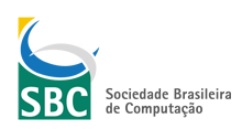Extending the MOISE model with adjustable autonomy
Resumo
Having autonomy and being part of an organization can be opposite concepts. Autonomy lets an agent take his own decisions, while sometimes, being part of an organization constraints these decisions to the ones allowed by the organization. This works presents an idea to combine these aspects, by allowing an agent to have autonomy even if it take part of an organization. We present different types of roles and goals to tackle this problem, characterizing what is called adjustable autonomy.Referências
Barber, K. S., Martin, C. E., Reed, N. E., and Kortenkamp, D. (2000). Dimensions of adjustable autonomy. In Pacific Rim International Conference on Artificial Intelligence, pages 353–361. Springer.
Behrens, T. M., Dastani, M., Dix, J., Hübner, J., Köster, M., Novák, P., and Schlesinger, F. (2012). The multi-agent programming contest. AI Magazine, 33(4):111–113.
Cardoso, R. C. (2014). Integrating automated planning with a multi-agent system development framework. Master’s thesis, Pontifícia Universidade Católica do Rio Grande do Sul.
De Brito, M., Hübner, J. F., and Boissier, O. (2015). Coupling regulative and constitutive dimensions in situated artificial institutions. In European Conference on Multi-Agent Systems, pages 318–334. Springer.
Falcone, R. and Castelfranchi, C. (1999). Levels of delegation and levels of adoption as the basis for adjustable autonomy. In Congress of the Italian Association for Artificial Intelligence, pages 273–284. Springer.
Falcone, R. and Castelfranchi, C. (2001). The human in the loop of a delegated agent: The theory of adjustable social autonomy. IEEE Transactions on Systems, Man, and Cybernetics-Part A: Systems and Humans, 31(5):406–418.
Franco, M. R. and Sichman, J. S. (2014). Comparing and evaluating organizational models: a multi-agent programming contest case study. In International Workshop on Coordination, Organizations, Institutions, and Norms in Agent Systems, pages 182–196. Springer.
Hübner, J. F. (2003). Um modelo de reorganização de sistemas multiagentes. PhD thesis, Universidade de São Paulo.
Hübner, J. F., Sichman, J. S., and Boissier, O. (2004). Using the\ mathcal {M} oise+ for a cooperative framework of mas reorganisation. In Advances in artificial intelligence–SBIA 2004, pages 506–515. Springer.
Nau, D. S., Au, T.-C., Ilghami, O., Kuter, U., Murdock, J. W., Wu, D., and Yaman, F. (2003). Shop2: An htn planning system. J. Artif. Intell. Res.(JAIR), 20:379–404.
Van Der Vecht, B., Dignum, F., Meyer, J.-J. C., and Neef, M. (2008). A dynamic coordination mechanism using adjustable autonomy. In Coordination, Organizations, Institutions, and Norms in Agent Systems III, pages 83–96. Springer.
Van Riemsdijk, M. B., Dastani, M., and Winikoff, M. (2008). Goals in agent systems: a unifying framework. In Proceedings of the 7th international joint conference on Autonomous agents and multiagent systems-Volume 2, pages 713–720. International Foundation for Autonomous Agents and Multiagent Systems.
Behrens, T. M., Dastani, M., Dix, J., Hübner, J., Köster, M., Novák, P., and Schlesinger, F. (2012). The multi-agent programming contest. AI Magazine, 33(4):111–113.
Cardoso, R. C. (2014). Integrating automated planning with a multi-agent system development framework. Master’s thesis, Pontifícia Universidade Católica do Rio Grande do Sul.
De Brito, M., Hübner, J. F., and Boissier, O. (2015). Coupling regulative and constitutive dimensions in situated artificial institutions. In European Conference on Multi-Agent Systems, pages 318–334. Springer.
Falcone, R. and Castelfranchi, C. (1999). Levels of delegation and levels of adoption as the basis for adjustable autonomy. In Congress of the Italian Association for Artificial Intelligence, pages 273–284. Springer.
Falcone, R. and Castelfranchi, C. (2001). The human in the loop of a delegated agent: The theory of adjustable social autonomy. IEEE Transactions on Systems, Man, and Cybernetics-Part A: Systems and Humans, 31(5):406–418.
Franco, M. R. and Sichman, J. S. (2014). Comparing and evaluating organizational models: a multi-agent programming contest case study. In International Workshop on Coordination, Organizations, Institutions, and Norms in Agent Systems, pages 182–196. Springer.
Hübner, J. F. (2003). Um modelo de reorganização de sistemas multiagentes. PhD thesis, Universidade de São Paulo.
Hübner, J. F., Sichman, J. S., and Boissier, O. (2004). Using the\ mathcal {M} oise+ for a cooperative framework of mas reorganisation. In Advances in artificial intelligence–SBIA 2004, pages 506–515. Springer.
Nau, D. S., Au, T.-C., Ilghami, O., Kuter, U., Murdock, J. W., Wu, D., and Yaman, F. (2003). Shop2: An htn planning system. J. Artif. Intell. Res.(JAIR), 20:379–404.
Van Der Vecht, B., Dignum, F., Meyer, J.-J. C., and Neef, M. (2008). A dynamic coordination mechanism using adjustable autonomy. In Coordination, Organizations, Institutions, and Norms in Agent Systems III, pages 83–96. Springer.
Van Riemsdijk, M. B., Dastani, M., and Winikoff, M. (2008). Goals in agent systems: a unifying framework. In Proceedings of the 7th international joint conference on Autonomous agents and multiagent systems-Volume 2, pages 713–720. International Foundation for Autonomous Agents and Multiagent Systems.
Publicado
04/05/2017
Como Citar
MAIA, Artur Vidal; SICHMAN, Jaime Simão.
Extending the MOISE model with adjustable autonomy. In: WORKSHOP-ESCOLA DE SISTEMAS DE AGENTES, SEUS AMBIENTES E APLICAÇÕES (WESAAC), 11. , 2017, São Paulo/SP.
Anais [...].
Porto Alegre: Sociedade Brasileira de Computação,
2017
.
p. 181-186.
ISSN 2326-5434.
DOI: https://doi.org/10.5753/wesaac.2017.33239.



